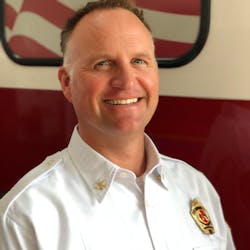As a baseball fan, the analogy of going on-deck for a fireground resonates with me. I visualize stepping out of the dugout, separating from distractions and getting onto the same plane as the game. Just a few feet outside of the action, you can time pitches, watch the base runner take a lead and look to the pitcher for clues. My mind plays out the potential situations: if the runner advances to third, and there is one out; if there are runners on first and third, and there are no outs, etc. The on-deck position sets you up for anticipatory observation of the competitive field and the game tempo.
Blue Card Command brought the idea of a fireground on-deck assignment to a national audience. It stresses the purpose and value of a forward-staged, engaged-mind, ready-state resource.
I know: Baseball isn’t for everyone, and the “on deck” concept might not be clear. When other fire service culture and training influences also are factored in, the original intent, value and definition of the assignment and mindset can be lost.
Rescue-ready or ready to work
The fire service has invested great time, training and resources to improve firefighter safety. Firefighter rescue and rapid intervention have been major focuses of these initiatives. For this reason, discussion about an on-deck crew inherently involves them both. Recently, there has been greater review of firefighter mayday and rapid intervention situations. Most of these reviews demonstrate that the firefighters who get in trouble are members of a working crew, and they most often are assisted or rescued by working crews.
When I completed the Blue Card Command Certification, it was at a high point of rapid intervention and firefighter rescue training for our organization. Given that timing, the message that I received was that on-deck crews were to think and prepare for firefighter rescue first. It wasn’t long before this bled into a definition—formally or informally—that on-deck was the rapid intervention team (RIT). I know intent was good; unfortunately, there was an unintended consequence. Concentrating on-deck on RIT narrowed the focus of a forward-staged, engaged-mind, ready-state resource. That’s the equivalent of spending time in the on-deck circle thinking about a squeeze bunt to bring a runner home from third, and then stepping to the plate with no runners on and two outs.
When we break down the information that most firefighters who get in trouble are members of a working crew, and they most often are assisted or rescued by other working crews, the true need is discovered. During these events, there likely is a compromise of active and critical fireground assignments. If an on-deck crew—pre-primed to engage in the firefighter rescue—also immediately becomes involved, the potential exists that firefighter focus and resource commitment is the rescue. The dynamic situation to which resources originally were deployed now develops without the countermeasures to tactical backfill that was present minutes before.
By definition, rapid intervention is quickly getting involved, but we have chained it to firefighter rescue. A team is a group who works together, but we have reduced this to a single crew and not the fire scene in its entirety.
As better firefighter rescue information emerged, so, too, has data that show that the majority of civilian rescues also require a full crew. We want to be as prepared as we can be for saving our own, but we are sworn to, employed by and called to fires by citizens, and they are our true priority. If fire attack or a search crew contacts a victim while operating, a decision must be made: Stop progress of the assignment and execute the removal or continue the assignment and call a crew for victim removal.
So, you’re on deck. Who’s on first? Rescues of civilians and firefighters happen from the inside out. This isn’t about who is first. It’s about what must come first—a successful fireground outcome.
When you’re on deck, you are the next up to get in the game and rapidly intervene in a way that supports the entire fireground. This most likely will involve quickly reacting to backfill initial attack, throw ladders or resume a search. All of these tasks support or prevent rescues.
In the game before you’re in
As an incident commander, take advantage of formally establishing a forward-staged, engaged-mind, ready-state resource when possible. As a company officer or firefighter, informally take advantage of unassigned time with an on-deck mindset. Get onto the same plane as the game. Focus on conditions, operations, members and radio traffic. Make your transition into any situation as well-prepared, well-timed and well-informed as possible.
About the Author
Brian Brush
Brian Brush is a 20-year veteran of the fire service. His experience includes rural and metro-sized departments. He currently is the chief of training for the Midwest City, OK, Fire Department. Previously, Brush served with the Edmond, OK, Fire Department and the West Metro, CO, Fire Rescue. He teaches around the country and will deliver the keynote address at Firehouse Expo 2020 in Nashville on July 23.
